| Pages:
1
2
3 |
Texium
Administrator
       
Posts: 4508
Registered: 11-1-2014
Location: Salt Lake City
Member Is Offline
Mood: PhD candidate!
|
|
Recommendations for Geiger Counter or Scintillation Detector
I've been considering purchasing some kind of radiation detecting device for doing some future uranium ore hunting and radiochemistry. I went to
Google and began looking at various Geiger counters and scintillation detectors, and was very overwhelmed by the sheer number of different ones and
the wide range of prices. I honestly have no idea how to determine what kind I should buy. In fact, I don't even know whether a Geiger counter or a
scintillation detector would be better for what I need. I was hoping that some of the resident radiochemistry enthusiasts would be able to help me
out.
|
|
|
aga
Forum Drunkard
    
Posts: 7030
Registered: 25-3-2014
Member Is Offline
|
|
Since Fukishima, there are several models made and sold in Japan.
I got one that says it measures micro sieverts/hour which is very portable, yet very unintersting.
I also got this kit :-
http://www.ebay.co.uk/itm/NEW-NetIO-Geiger-Counter-Embedded-...
which includes an SBM-20U tube.
Other tubes are supposedly supported, although i have no info as to the differences.
|
|
|
Ozone
International Hazard
    
Posts: 1269
Registered: 28-7-2005
Location: Good Olde USA
Member Is Offline
Mood: Integrated
|
|
In reality, you'd want both. Geiger tubes are sensitive primarily to beta (and alpha if the window is thin enough). The counting efficiency for gammas
is very low. On the other hand, a typical [say, NaI(Tl)] scintillation detector is very sensitive for gammas and (for sealed probes) nothing else.
For prospecting I'd recommend a decent scaler (say, Ludlum 14C or Eberline 510; see Ebay) and a pancake probe (good for alpha/beta with a removable
beta/gamma shields). The Ludlum scalers are also directly useful (and can be voltage tuned to whatever plateau you need) with a cheap, but sensitive
scintillator such as a Bicron 1.12X1.12M3/1.2L (about $99 USD).
For spectroscopy, I use a Ludlum 44-10 2x2" NaI(Tl) with a Gamma Spectacular GS-1100-Pro soundcard MCA & variable PSU...but, that's another story.
O3
-Anyone who never made a mistake never tried anything new.
--Albert Einstein
|
|
|
neptunium
National Hazard
   
Posts: 985
Registered: 12-12-2011
Location: between Uranium and Plutonium
Member Is Offline
|
|
if you doing some prospecting you might want the scintillation type they are more sensitive to gamma ray as Ozone pointed out, and most uranium and
thorium ore have gamma emission .
this one is very simple yet rugged, perfect for carrying around ...
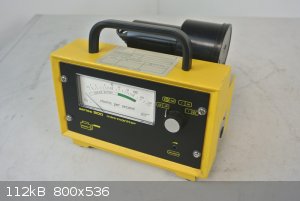
for radio chemistry and isotopes identification you`ll need a gamma spectrometer and a alpha spectrometer but thats a different range of prices..
|
|
|
careysub
International Hazard
    
Posts: 1339
Registered: 4-8-2014
Location: Coastal Sage Scrub Biome
Member Is Offline
Mood: Lowest quantum state
|
|
Suggestions are right - you want a sensitive gamma detector for survey work due to their range in air.
All natural ores of uranium and thorium will have accumulated decay chain products that put out strong gammas.
There are quite a variety of radiation detectors available in Japan now, thanks to Fukushima, many marketed to the mass public. The health monitor
read-outs(microsieverts/hour., etc.) are less useful than raw click-counting devices.
For close up specimen work I have been looking at Geiger counter kits, of which there are several available from $75-$100 for the counter itself (w/o
tube) but you need to assemble them.
A good tube to use is the LND712:
https://www.sparkfun.com/datasheets/Components/General/LND-7...
for $95. It has an alpha end window. With different screens (e.g. thicknesses of aluminum or what-have-you) you can generate some information on the
emission profile of a specimen. You need to confirm that the voltage handled by any kit is compatible with that required by the tube you want to use.
It was not until 1928 that the Geiger counter was invented, and the electronic scintillation counter was not invented until 1944, so quite a lot of
radiochemistry was done before fancy gamma ray spectometry was available. This is similar to the situation with GLC and HPLC chromatography which are
considered essential for chemistry labs today, yet nearly two centuries of successful chemistry preceded them, and the modern hobbyist does quite a
lot without.
[Edited on 17-7-2015 by careysub]
[Edited on 17-7-2015 by careysub]
|
|
|
Texium
Administrator
       
Posts: 4508
Registered: 11-1-2014
Location: Salt Lake City
Member Is Offline
Mood: PhD candidate!
|
|
Thank you all for the suggestions! I've been looking over the different ones posted here, and the one that neptunium suggested seems to be the one
that is most in my price range. I found a used one on eBay for a good price: http://www.ebay.com/itm/321368691563?_trksid=p2055119.m1438....
I just wanted to make sure though: that detector with that tube will work well for identifying uranium ore? And I don't really need anything fancy for
lab work, I just wanted to be able to check for contamination in my lab and on my glassware with it. Sorry that I'm so illiterate when it comes to the
specs of these things.
|
|
|
Ozone
International Hazard
    
Posts: 1269
Registered: 28-7-2005
Location: Good Olde USA
Member Is Offline
Mood: Integrated
|
|
A good scintillator (at proper voltage for the PMT) will detect (decent) Uranium ore easily 1-2 away. So...yes.
Background counts are higher, too, though, so you might want to make sure you can mute the audio output (it's cool at first, but gets old quickly).
edit: Ugh, I just noticed the one you are looking at is a GM...Regardless, it will be more than enough to get you started (presuming it works).
O3
[Edited on 17-7-2015 by Ozone]
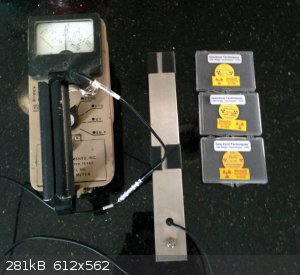 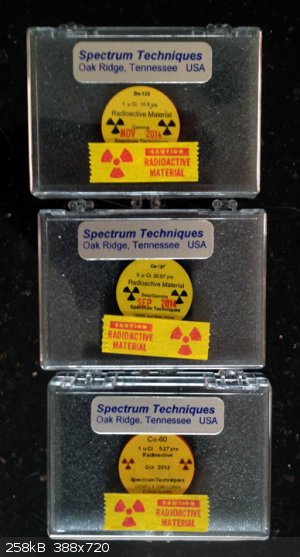
[Edited on 18-7-2015 by Ozone]
-Anyone who never made a mistake never tried anything new.
--Albert Einstein
|
|
|
pneumatician
Hazard to Others
  
Posts: 409
Registered: 27-5-2013
Location: Magonia
Member Is Offline
Mood: ■■■■■■■■■■ INRI ■■■■■■■■■■ ** Igne Natura Renovatur Integra **
|
|
Another cheap option is this:
http://petapixel.com/tag/scintillator/
someone tested this? Also is used for astrophoto, another very interesting use!!
|
|
|
neptunium
National Hazard
   
Posts: 985
Registered: 12-12-2011
Location: between Uranium and Plutonium
Member Is Offline
|
|
to Careysub
use 0.1uF for C and 100Kohm for R
runs at about 2000V DC
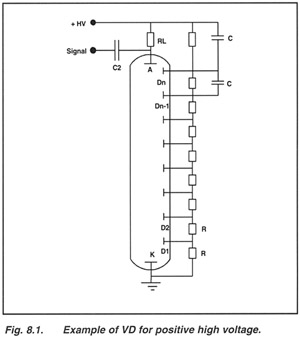
|
|
|
Sulaiman
International Hazard
    
Posts: 3555
Registered: 8-2-2015
Location: 3rd rock from the sun
Member Is Offline
|
|
I will try to find the circuit diagram (from Hamamatsu application notes somewhere)
in which the multi-stage Cockroft-Walton type multiplier gives c100 v per stage (suitable for my photomultiplier, others may differ),
combining multiplier and divider in a low loss circuit.
It is such a useful circuit that it must be quite common.
Edit: found it, or similar, https://www.hamamatsu.com/resources/pdf/etd/PMT_handbook_v3a...
page 96
P.S. increasing capacitance value of the capacitors drawn in the diagram in the right hand 'column' decreases ripple voltages.
P.P.S. a worthwhile reference if you are considering using a photomultiplier.
[Edited on 26-11-2015 by Sulaiman]
[Edited on 26-11-2015 by Sulaiman]
|
|
|
careysub
International Hazard
    
Posts: 1339
Registered: 4-8-2014
Location: Coastal Sage Scrub Biome
Member Is Offline
Mood: Lowest quantum state
|
|
Scintillation Probes
Neptunium's post is in connection with a project I have started for building scintillation probes and systems.
Currently I am using a nice kit put together by "iradinc" on eBay, using a 3" Hamamatsu R10133 PMT Photomultiplier Tube, and a 3"x2.25" plastic
scintillation block. it is intended for sweeping along the ground for field surveying, so it needs to be rugged. I would be using it with a Ludlum
2221 rate meter/scaler.
I already have a Ludlum 44-2 gamma detector scintillator, 2.5 D x 2.5 cm Nal crystal.
http://www.ludlums.com/component/virtuemart/area-monitoring-...
I am also interested in experimenting with gamma spectroscopy, and trying a cheap set-up seems the way to begin.
|
|
|
careysub
International Hazard
    
Posts: 1339
Registered: 4-8-2014
Location: Coastal Sage Scrub Biome
Member Is Offline
Mood: Lowest quantum state
|
|
What is the recommended procedure for coating the scintillation block/PM tube interface?
I have experience doing oil separated achromatic lenses - there you just put a drop of oil in the concave lens surface, place the second lens on top
and wait a day or so for the film to migrate to the edge. If it does not, you can always separate them and try again (and it is easy to see).
With the thicker optical "grease" and the fact that you can't see how even the the coat is, thinks look a little trickier.
My plan was to make a ~quarter sized smear on the PM tube (as even as I can), heat the plastic block up to maybe 60 C, and place the tube on top with
a bean bag weight, and wait for the stuff to migrate to the edge. I am not using this probe for spectroscopy, just pulse counting, so I imagine the
requirements aren't as stringent.
|
|
|
IrC
International Hazard
    
Posts: 2710
Registered: 7-3-2005
Location: Eureka
Member Is Offline
Mood: Discovering
|
|
A few useful PDF's I have accumulated, size too great in total for one post.
Attachment: Photomultiplier_Handbook.pdf (4.2MB)
This file has been downloaded 1310 times
Attachment: pmtinfo.pdf (19kB)
This file has been downloaded 1746 times
Attachment: scintillation_probe.pdf (99kB)
This file has been downloaded 995 times
Attachment: ScintillatorsData.pdf (1.5MB)
This file has been downloaded 1030 times
"Science is the belief in the ignorance of the experts" Richard Feynman
|
|
|
IrC
International Hazard
    
Posts: 2710
Registered: 7-3-2005
Location: Eureka
Member Is Offline
Mood: Discovering
|
|
I think the values in neptunium's circuit should be looked at. 0.1 uF is going to give a somewhat slow time constant, especially for NaI/Tl, and using
100K resistors gives rise to excessive current flow and therefore more noise than necessary.
Attachment: Scintillators.pdf (3.9MB)
This file has been downloaded 1003 times
Attachment: dt590_to_nai.pdf (538kB)
This file has been downloaded 1004 times
Attachment: Amperex_1958.pdf (743kB)
This file has been downloaded 873 times
Attachment: xp2102data.pdf (83kB)
This file has been downloaded 953 times
However the reason I am posting is to see if anyone can answer a question. I have found a couple places that can restore old NaI/Tl crystals that were
yellowing/shrinking, yet charge too much for me to have it done. I doubt either one would provide their secret methods, I know slow careful heating is
involved. I am wanting to save a project I put much effort into which ended up going nowhere due to a less than honest seller. Twice I purchased a
great looking end on mica window tube for $80 each and both were useless. I used a case from a CDV700, built a board for the HV power supply and
analog circuitry, a regulator so I had clean voltage sources to run a blue 16x2 LCD and Arduino Mega 2560, with four 18650 Li-ion batteries. Even
added a regulator so I could just plug in a wall wort and recharge the 12 volt Li-ion battery pack. All in all a very great looking project. Problem
is both tubes have lost their quench gas over the years through the mica windows so no matter how carefully adjusted and regulated by a very good
circuit I designed the NOS tubes just go into avalanche when I get in the range for detection. Put simply the seller ripped me off for $160 total on
these tubes leaving the entire project DOA. So I finally decided to use the PM tube - NaI/Tl assembly I salvaged from a 111B scintillator (the model
that looks like a cool chrome ray gun). However the trouble there is dried out optical coupling and yellow crystal. I have the optical grease of the
proper type so all I need to do is fix the crystal and remount it, and do a little redesign on the high voltage analog section. If I had received good
GM tubes as advertised this project would have been a done deal almost 2 years ago. I had intended one to be a spare or possibly a whole new project.
Appears the best low cost way to salvage my effort and money is to just build a scintillator out of this project. Assuming I can learn the proper way
to restore my crystal without harming it. Anyone have useful information on the process?
Just remembered I had in the beginning posted some pics of this project before all the work was done and before the digital display + Mega had been
added. You can see one of the two defective tubes the ebay seller sent me. Didn't work due to quench problems so hoping to get lucky on NOS I yet
again risked $80 as only he had this type tube and I searched a long time. Had to take the risk to justify the effort building this project, I was
finished with all work but the tube was a failure.
http://www.sciencemadness.org/talk/viewthread.php?tid=28985
Attachment: gamma.pdf (520kB)
This file has been downloaded 1283 times
Attachment: NaI(Tl) Data Sheet.pdf (275kB)
This file has been downloaded 972 times
Attachment: Refurbishing an old but special large detector.pdf (2.6MB)
This file has been downloaded 1115 times
This last file is useful for information but no way would I be sawing my NaI/Tl crystal. Having suffered from Tl poisoning decades ago I find creating
a pile of the dust moronic at best unless one likes to lay in bed at night soaking in sweat for a very long time. Also the purpose of the optical
grease is to aid light coupling and creating a surface looking like the craters of the moon on a microscopic scale is not a good idea. Not to mention
polishing the surface is yet another source of Tl poisoning. The amount that can do serious long term harm is extremely low. Therefore I advise do not
do what this person did even if it did seem to work for him.
[Edited on 12-9-2015 by IrC]
"Science is the belief in the ignorance of the experts" Richard Feynman
|
|
|
IrC
International Hazard
    
Posts: 2710
Registered: 7-3-2005
Location: Eureka
Member Is Offline
Mood: Discovering
|
|
On my comment about the PM circuit values posted previously, I suggest this image be studied.
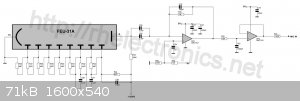
Source:
http://www.rhelectronics.net/store/simple-homemade-diy-gamma...
"Science is the belief in the ignorance of the experts" Richard Feynman
|
|
|
neptunium
National Hazard
   
Posts: 985
Registered: 12-12-2011
Location: between Uranium and Plutonium
Member Is Offline
|
|
Quote: Originally posted by careysub  | What is the recommended procedure for coating the scintillation block/PM tube interface?
I have experience doing oil separated achromatic lenses - there you just put a drop of oil in the concave lens surface, place the second lens on top
and wait a day or so for the film to migrate to the edge. If it does not, you can always separate them and try again (and it is easy to see).
With the thicker optical "grease" and the fact that you can't see how even the the coat is, thinks look a little trickier.
My plan was to make a ~quarter sized smear on the PM tube (as even as I can), heat the plastic block up to maybe 60 C, and place the tube on top with
a bean bag weight, and wait for the stuff to migrate to the edge. I am not using this probe for spectroscopy, just pulse counting, so I imagine the
requirements aren't as stringent. |
Yes it is very tricky. I had a lot of trouble with that interface. EBay has this optical grease for sale pretty cheap but very difficult to get a
clear coating between the crystal and the PM tube... I had good results with baby oil but it always evaporate after a while. You might be on to
something with some form of wax...
It is vitaly important it is to have the best optical connection as possible for spectroscopy otherwise the spectrum looks like one big ugly smudge
|
|
|
Somerset
Harmless

Posts: 5
Registered: 16-3-2017
Member Is Offline
Mood: No Mood
|
|
Model car diff heavy silicon grease can be used as optical grease
|
|
|
Radium212
Hazard to Self
 
Posts: 85
Registered: 26-6-2017
Member Is Offline
Mood: Pyrophoric.
|
|
Quote: Originally posted by zts16  | | I've been considering purchasing some kind of radiation detecting device for doing some future uranium ore hunting and radiochemistry. I went to
Google and began looking at various Geiger counters and scintillation detectors, and was very overwhelmed by the sheer number of different ones and
the wide range of prices. I honestly have no idea how to determine what kind I should buy. In fact, I don't even know whether a Geiger counter or a
scintillation detector would be better for what I need. I was hoping that some of the resident radiochemistry enthusiasts would be able to help me
out. |
For a nice, cheap Geiger counter use the GMC 300E +. For something more rugged, and with a probe try a Ludlum (expensive), or maybe get an old CD
V-700.
|
|
|
diddi
National Hazard
   
Posts: 723
Registered: 23-9-2014
Location: Victoria, Australia
Member Is Offline
Mood: Fluorescent
|
|
Radiation detector for minerals on a budget
I have been looking at radiation detectors available for the application of element sample testing, but more importantly, mineral ID and composition.
There are many available online with prices from USD20 to USD (more than i can afford)
The issue with minerals is that the bulk of the decays likely to be detected are alpha emissions. All of the cheap detectors do not detect alpha so
they are no use for my applications.
So my question to the radiochemists here is "Can i make my own geiger counter". Can i build an interface to PC and use different tubes for different
radiation types? I dont know enough about the possibilities.
I do know about the gamma spectroscopy project in progress, but i am on a budget and just dont have thousands to invest in a tool that is really only
supporting a hobby. TIA
Beginning construction of periodic table display
|
|
|
LearnedAmateur
National Hazard
   
Posts: 513
Registered: 30-3-2017
Location: Somewhere in the UK
Member Is Offline
Mood: Free Radical
|
|
Am-241 based smoke detectors work via alpha radiation, maybe one of these can be modified into a makeshift Geiger counter that works via
current/voltage? I’m useless when it comes to electronics so I can’t help you out there though, but other members should be able to give you some
pointers.
In chemistry, sometimes the solution is the problem.
It’s been a while, but I’m not dead! Updated 7/1/2020. Shout out to Aga, we got along well.
|
|
|
Harristotle
Hazard to Others
  
Posts: 138
Registered: 30-10-2011
Location: Tinkerville
Member Is Offline
Mood: I tink therefore I am
|
|
Most alpha emitters are not pure alpha emitters - they undergo secondary gamma emission as the k shell electrons rearrange themselves to cope with a
great big gob of nuclear material being ripped out of them.
For this reason, a good gamma detector can detect classical "alpha" emitters, even though the window should stop everything.
However, those inner electron rearrangements are also often not very energetic, and you still need to be close to detect.
(A very old and dusty crypt in my mind just opened to remember that!)
|
|
|
j_sum1
Administrator
       
Posts: 6218
Registered: 4-10-2014
Location: Unmoved
Member Is Offline
Mood: Organised
|
|
I have seen yt clips on making your own geiger cointer. I don't know how well they work.
|
|
|
Harristotle
Hazard to Others
  
Posts: 138
Registered: 30-10-2011
Location: Tinkerville
Member Is Offline
Mood: I tink therefore I am
|
|
Well, I wrote one for an arduino a long while ago.
I ran the arduino off a 9 volt battery, and cannabilised an old camera with flash to get a cheap and highly efficient hv supply (cost 50 cents at
Vinnies - aka a thrift store for those not of the great southern land).
I put a 1uF capacitor and 4 x 100v zener in series then fed a sbm20 russian tube in series with a 10 meg ohm resistor. I coupled the junction of the
tube and the resistor to an optocoupler via a small capacitor (100pF I think) and used the output photodiode to trigger one of the digital pins on the
arduino. Something like this:
It works well, and is able to "see"a uranium glass button I have at over 4 times background.
Code: (Some pinched, some my own)
/* Geiger Counter Interface Example BroHogan 1/26/10
* A very simple example of interfacing to the Geiger Counter circuit and counting
* the events / min. It triggers an LED and piezo for each event but this is not
* necessary since these are included in the circuit.
* *INT from circuit is connected to PIN 2 and triggered as FALLING.
*
* Keypad LCD notes: The keypad uses a single a/d line (A0) and it reads the
* resistance. The keys are aranged as a "resistance ladder", so you can tell by the
* resistance on A0 which key is pressed. Pin 13 generated the voltage at the top of
* the ladder, so to poll the keys you must both set pin 13 high and read A0
* Circuit notes:
* This works with the following:
*
*
* 4N25 optocoupler
*
*<--------| /-------/\/\/\-----+ve 5v
* | ^ |/
* V / |
* --- / |\ ____________/\/\/\_____> int pin 3
* | v |
*<--------- ------|-->|----|
* to gm circuit |
*LED Led1 |
* white V gnd
* 3.9v bandgap
*/
//#include <LCD4Bit_mod.h> // 4 bit lcd keypad shield
//#include <Tone.h> // used for non-blocking tone
#include <TimedAction.h> // THIS LIB MODIFIED - now uses long & public interval
#define PIEZO_PIN 13
#define LED_PIN 11 // pin 11 is led to flash in time with counts
#define PERIOD 10000 // collect counts in 10 seconds
#define DISP_FREQ 5000 // how often to display counts
#define TONE_FREQ 4000
//Tone tone;
TimedAction cntDisp = TimedAction(DISP_FREQ,displayCount); // instanciate timed action for display
//LCD4Bit_mod lcd = LCD4Bit_mod(2); // make an lcd object
volatile boolean newEvent = false; // indicates a new event was caught by ISR
unsigned long startTime, startPeriod;
unsigned long cpmCnt, dispCnt, totalCnt, totalCPM, totalPeriods;
char countstring [15];
void setup(){
cpmCnt = 0;
dispCnt =0;
totalCnt = 0;
totalCPM =0;
Serial.begin(9600);
pinMode(LED_PIN,OUTPUT);
//pinMode(3,OUTPUT); //put geiger pin into low impedence state
//attachInterrupt(0,GetEvent,FALLING); // Geiger event on pin 2 triggers interrupt
attachInterrupt(1,GetEvent,FALLING); // Geiger event on pin 3 triggers interrupt
// tone.begin(PIEZO_PIN);
startTime = millis();
startPeriod = startTime;
pinMode(13, OUTPUT); //we'll use the debug LED to output a heartbeat to drive keypad
//lcd.init();
//optionally, now set up our application-specific display settings, overriding whatever the lcd did in lcd.init()
//lcd.commandWrite(0x0F);//cursor on, display on, blink on. (nasty!)
// lcd.clear();
//lcd.printIn("Geiger counter");
//lcd.cursorTo(2, 0); //line=2, x=0
//lcd.printIn("V1.0 by L Harris");
//delay(500);
//lcd.clear();
memset(countstring, 0, sizeof(countstring)); // fill LCD message with nulls
}
void loop(){
cntDisp.check(); // check if should display the counts
if (millis() > startPeriod + PERIOD) Reset_Counter();
if (newEvent){
updateCount();
//tone.play(TONE_FREQ,100); // short non-blocking tone
digitalWrite(LED_PIN,HIGH); // indicate an event
delay(25);
newEvent = false;
digitalWrite(LED_PIN,LOW);
}
}
void Reset_Counter(){ // aggragate totals and reset counters for each period
totalPeriods ++;
dispCnt = cpmCnt;
totalCPM += cpmCnt;
cpmCnt = 0;
startPeriod = millis(); // reset time
}
void updateCount(){
totalCnt++; // update total count since startup
cpmCnt++;
}
void displayCount(){
Serial.print(dispCnt * 6,DEC);
//lcd.cursorTo(2, 0); //line=2, x=0
//snprintf(countstring, 17, " "); // clear out the old garbage
//lcd.printIn(countstring);
//lcd.cursorTo(2, 0); //line=2, x=0
//snprintf(countstring, 15, "%i CPM", dispCnt);
// lcd.printIn(countstring);
Serial.print(" CPM ");
Serial.print(dispCnt * 4,DEC); // I've read that counts in 40 sec = uR/H
Serial.print(" uR/H ");
Serial.print("Avg CPM: ");
Serial.print((totalCPM * 6) / totalPeriods,DEC);
Serial.print(" Avg uR/H: ");
Serial.print((totalCPM * 4) / totalPeriods,DEC);
Serial.print(" Total Count: ");
Serial.println(totalCnt,DEC);
}
void GetEvent(){ // triggered for each new event
newEvent = true;
}
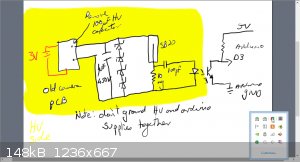
|
|
|
diddi
National Hazard
   
Posts: 723
Registered: 23-9-2014
Location: Victoria, Australia
Member Is Offline
Mood: Fluorescent
|
|
that looks rather interesting. some careful study required there. thx
Beginning construction of periodic table display
|
|
|
pantone159
National Hazard
   
Posts: 586
Registered: 27-6-2006
Location: Austin, TX, USA
Member Is Offline
Mood: desperate for shade
|
|
About the only common substance that will emit just alphas, and no gammas, is Po-210. That is not so significant in most minerals. You are better off
sure, with an alpha detector, but a gamma detector should get you something.
|
|
|
| Pages:
1
2
3 |